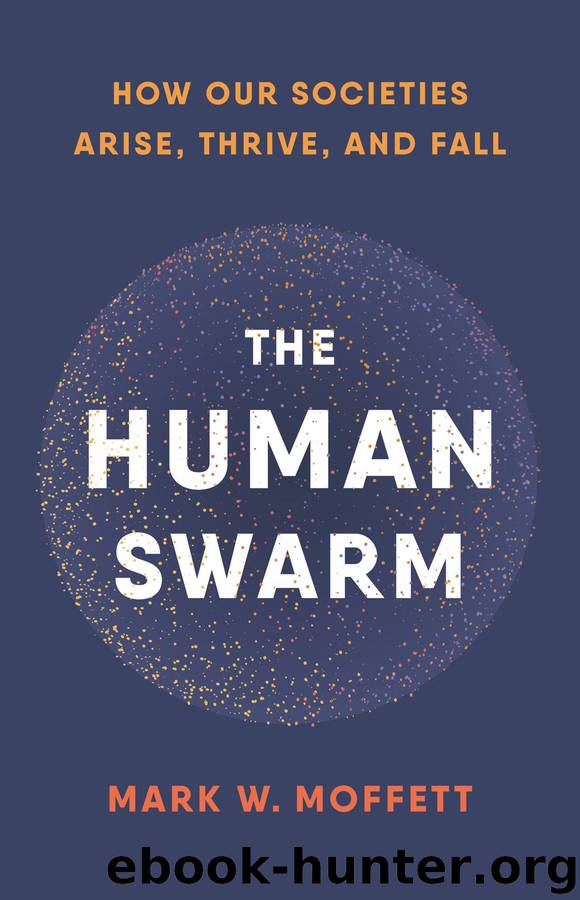The Human Swarm by Mark W. Moffett

Author:Mark W. Moffett
Language: eng
Format: epub
Publisher: Basic Books
Published: 2019-03-25T16:00:00+00:00
THE ULTIMATE SEVERING
Describing the fall of the Roman Empire, the nineteenth-century American senator Edward Everett wrote that the society had broken “into hostile atoms, whose only movement was that of mutual repulsion.”33 We can assume that for hunter-gatherers, too, the division would have been set in motion when each faction came to see the other as a hostile atom, its identity intolerable, its actions falling beyond the society’s boundaries of acceptable behavior, if only because of disagreements as to where those boundaries lay. If a society gives the world meaning by conveying a story about how life should work, what had been one story would have split in two.
No one has specifically modeled how a society might divide, but research by social psychologist Fabio Sani, much of it with colleague Steve Reicher, on schisms within different sorts of groups suggests factors that might come into play for entire societies, too.34 The Church of England split up after 1994 when the members who saw the ordination of women as contrary to the true nature of the church went their own way by devising other denominations. In a second example from the same time, the Italian communist party entered the mainstream and took a new name, causing a minority faction to splinter off into a new party that stuck to its principles and retained the party’s original symbols. In both situations the members who felt that the refinements enhanced their identity seized on the changes as mandatory. For them, those changes strengthened the group. The other members, though, interpreted the refinements as harmful deviations from the intangible essence that defined them, threatening their solidarity. The belief that their identity would be subverted drove a wedge between them and supporters of the change.
We might expect that most divisions have been prompted, now and in the past, by alterations in identity on both sides. Sani’s studies suggest there can be imbalances, however. The more conservative faction, the one espousing the least transformation—in hunter-gatherer times perhaps the people in the core of the territory who were buffered from outside influence and retained most of the society’s oldest attributes and original name—might have attracted those individuals we speak of today as nationalists, who abhor change. In the view of such people, dangerous behavior, which might have originated with a single black sheep, would have spread. What had been one estranged person worthy of chastising, or worse, would have metastasized into a faction acting inappropriately, even maliciously, as a unit. Such a faction can elicit a strong commitment from its members because of how likeminded they are. Factions express a narrower set of behavior than present across the whole society, making their solidarity easy to come by. However, the more radical side—occupying the fringes of the territory—would have seen things the same way, and felt just as unified about their own viewpoint. Because they would have seen the changes they promoted as essential to strengthening the same society, for them the dissidents would have been those conservatives refusing the improvement.
Download
This site does not store any files on its server. We only index and link to content provided by other sites. Please contact the content providers to delete copyright contents if any and email us, we'll remove relevant links or contents immediately.
Sapiens: A Brief History of Humankind by Yuval Noah Harari(14313)
Sapiens by Yuval Noah Harari(5321)
Pale Blue Dot by Carl Sagan(4950)
Homo Deus: A Brief History of Tomorrow by Yuval Noah Harari(4870)
Livewired by David Eagleman(3728)
Origin Story: A Big History of Everything by David Christian(3665)
Brief Answers to the Big Questions by Stephen Hawking(3392)
Inferior by Angela Saini(3293)
Origin Story by David Christian(3169)
Signature in the Cell: DNA and the Evidence for Intelligent Design by Stephen C. Meyer(3098)
The Gene: An Intimate History by Siddhartha Mukherjee(3074)
The Evolution of Beauty by Richard O. Prum(2962)
Aliens by Jim Al-Khalili(2802)
How The Mind Works by Steven Pinker(2769)
A Short History of Nearly Everything by Bryson Bill(2659)
Sex at Dawn: The Prehistoric Origins of Modern Sexuality by Ryan Christopher(2500)
From Bacteria to Bach and Back by Daniel C. Dennett(2462)
Endless Forms Most Beautiful by Sean B. Carroll(2442)
Who We Are and How We Got Here by David Reich(2416)
